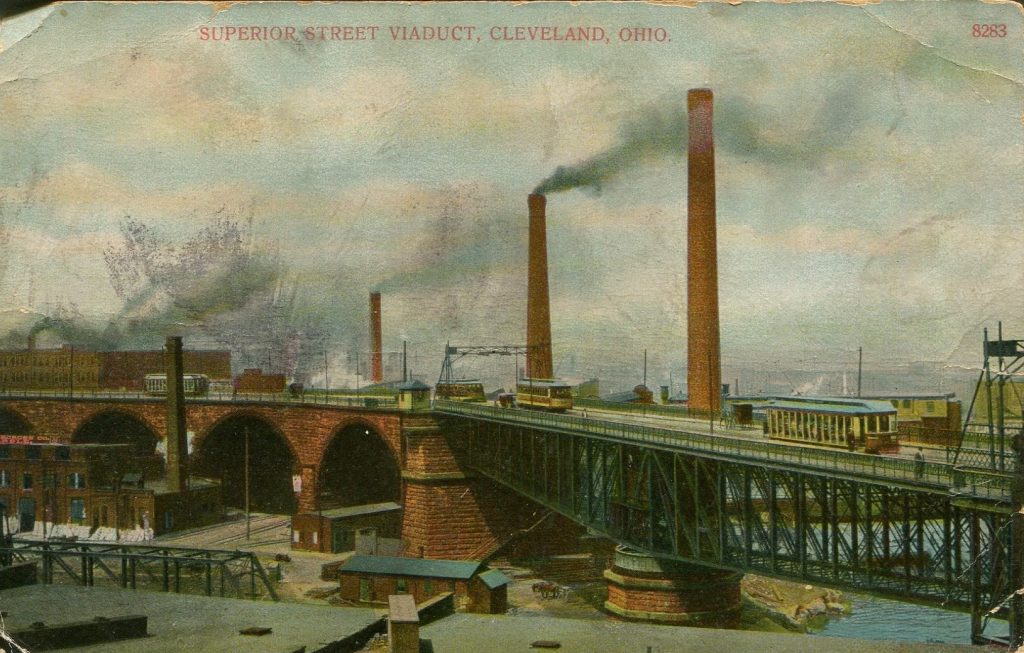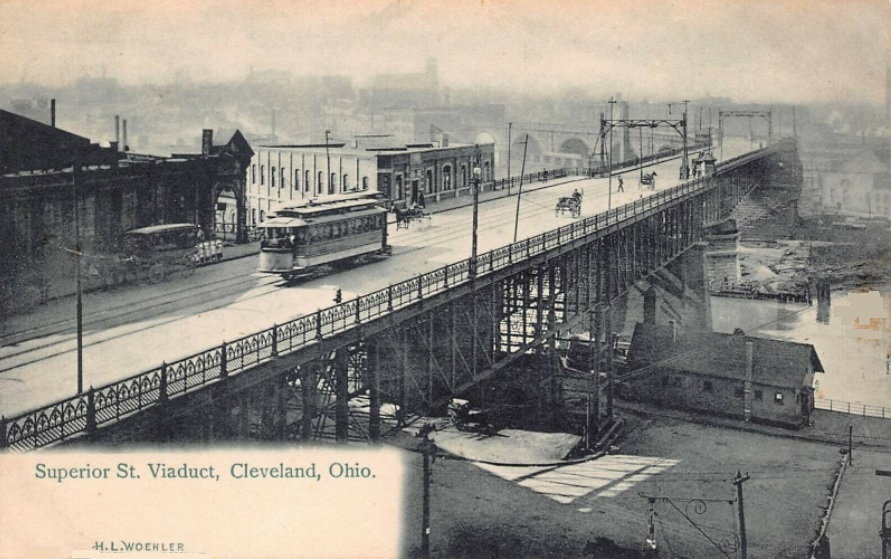Editor’s Staff
The Superior Avenue Viaduct

From a collector’s point-of-view this card is the Rodney Dangerfield of postcards; it deserves no respect. It is dirty, the corners are bent and cracked, the title is wrong (Superior is an Avenue, not a Street), and even the message (postmarked 1907) is inane: “Will be here until Friday. Love Dad.”
* * *
His name may not be familiar, but for sure, students of history are very aware of something he said. George Santayana was born in Spain but reared and educated in the United States. He was a philosopher and writer, mostly on historical topics and served as a professor at Harvard University until 1911.
He once said, “Those who cannot remember the past are condemned to repeat it.” Many academics have copied or paraphrased his words in defense of their own dissertations, but recently I found a quip from Kurt Vonnegut that is quite apropos. “I’ve got news for Mr. Santayana,” wrote Vonnegut, “we’re doomed to repeat the past no matter what. That’s what it is to be alive.”
* * *
Do you remember the butler at Downton Abbey? His name was Carson. In a scene, close to the end of the series, Mr. Carson is sitting on a parson’s bench with Mrs. Hughes, their conversation centers on the years they have worked together and their pending marriage. He says, to her, “After all, what is life except the accumulation of memories? For, in the end, that is all we have.”
* * *
These three, seemingly unrelated, memories may seem superfluous as introductions to a Postcard History lesson about a piece of road, an elevated trolley bridge and a Great Lakes shipping pier, but if you stay with me, I’ll tie them together.

In 1818 the good citizens of Brooklyn Township, Ohio, founded their city and called it Ohio City. Its location was to the immediate west of the Cuyahoga River and in many practical ways it was a worthy metropolitan neighborhood of Cleveland. At that time Cleveland was the largest city on the Lake Erie shoreline.
In March 1836 Cleveland was scheduled to become an incorporated city, but two days earlier Ohio City became a separate municipality. It stayed as such until 1854. In those 18 years the two cities became rivals in many ways. When cooler-heads prevailed (yes, violence erupted over the use of the Columbus Street bridge) Ohio City residents voted to join Cleveland for the advantages of large city services.
At that time all the bridges that crossed the Cuyahoga River were “low-level” bridges and a constant stream of river traffic required long and frequent “bridge-openings.” Finally in 1872 the city voters approved the construction of a new high-rise bridge – it was appropriately named the Superior Viaduct.
The Superior Avenue Viaduct was an architectural marvel in its day. Constructed to improve the flow of traffic across the Cuyahoga River, it extended from Superior Avenue and West 10th Street in the east to Detroit Avenue and West 25th Street in the west. The viaduct was 1,382 feet (over a quarter mile) long that set atop ten arches made of Berea sandstone. With the connecting approaches, the total length eclipsed 3,211 feet (six-tenths of a mile). Its roadbed was 64 feet wide. Total construction time: four years. It opened for traffic in December 1878.

This drawing of the Superior Avenue Viaduct from the 1880s shows the full extent of the structure. Traffic seems to move both east and west, but the drawspan at the center still had to open several times each month to allow river vessels with tall superstructures to pass. These delays became increasingly annoying and the citizens were often raucous about a new bridge that would be high enough to accommodate any size ship. In 1918 the Detroit-Superior Bridge opened and the Superior Avenue Viaduct closed. Demolition of the viaduct commenced in 1922, and in 1939 the easternmost three arches of the remaining sandstone segment were blasted away to ease passages on the river.
* * *

So the lessons learned are: even if the postcard is old, dirty, and is only holding a spot in your collection until a better copy is found – what may be termed a “Rodney Dangerfield” card is still one that will tell an interesting story.
Secondly, for certain in 1872, nobody in Cleveland knew what Professor Santayana would write or say thirty years later about repeating history, they did what they thought was right when they built a new bridge, but it was the wrong kind of bridge. They doomed themselves to continue life in the same horrible rut that led to the same horrible destination.
As for Mr. Carson’s observation concerning memories, that is all the people of Cleveland had for a long time. The Superior Avenue Viaduct has been blasted into the past. There is not a single soul to remember it – unless Cleveland has some 125 year old citizens.
The postcard is all that is left.
I have a Rotograph of one of the other Cleveland viaducts, the Central Viaduct, with an inscription that reads, “A street car went through this viaduct several years ago killing all passengers.”
The incident alluded to took place in 1895 and killed seventeen people. (There actually were a few survivors.)
Billy Joel’s song “We Didn’t Start the Fire” features the lyric “Santayana goodbye” as a reference to the philosopher’s 1952 death.
I love old post cards and the history they hold. If you want to learn local history don’t look to history books to find it, you will find local history in post cards. Great article on the The Superior Avenue Viaduct. I can’t wait to see one on the Clark Avenue Bridge that went over the steel mills of Cleveland. Hope someone will write it.
What a wonderful way of explaining why we collect vintage postcards! Thank for this beautiful article.
Great history lesson on the postcard and the progress and advancement of our country. Thanks.